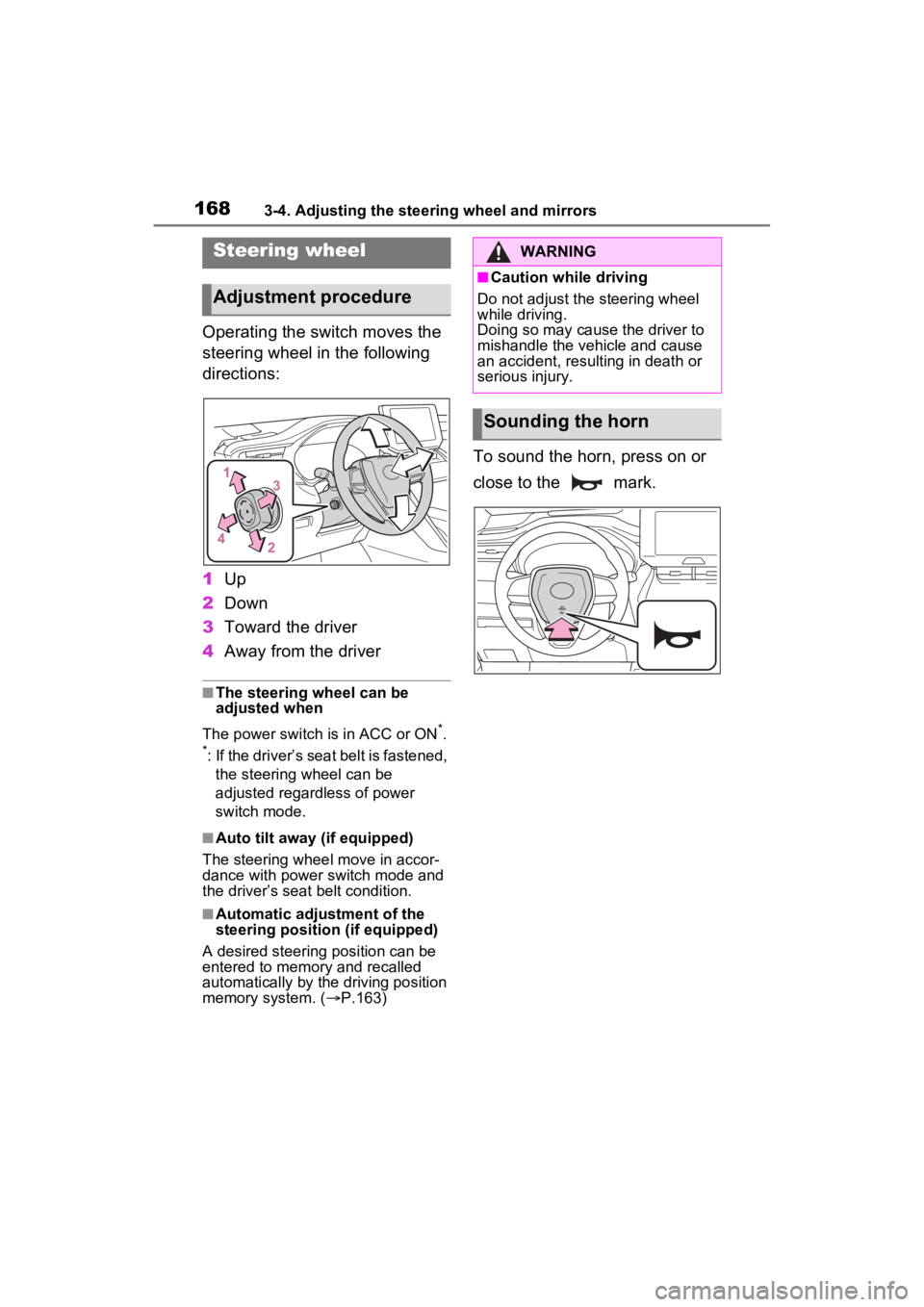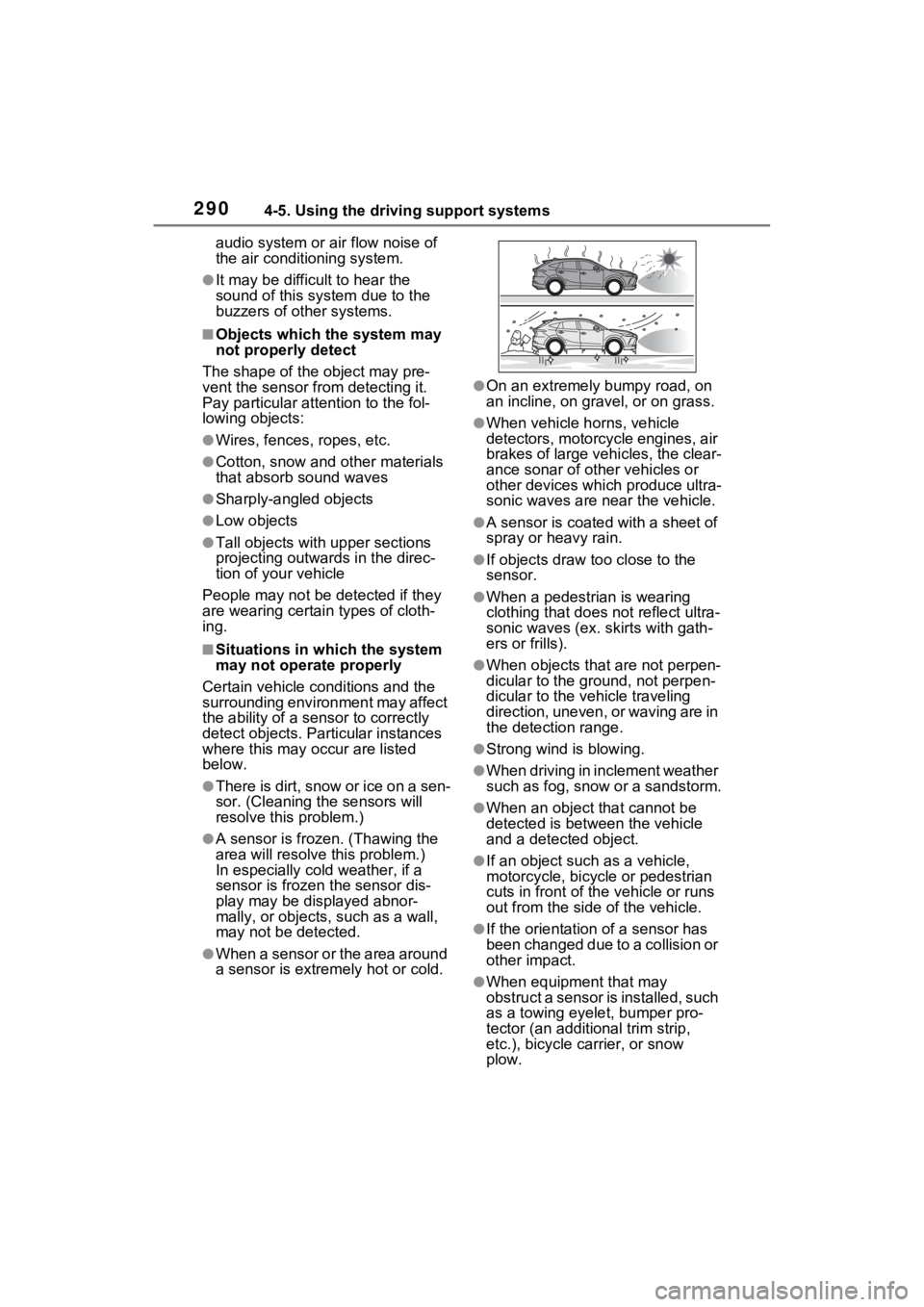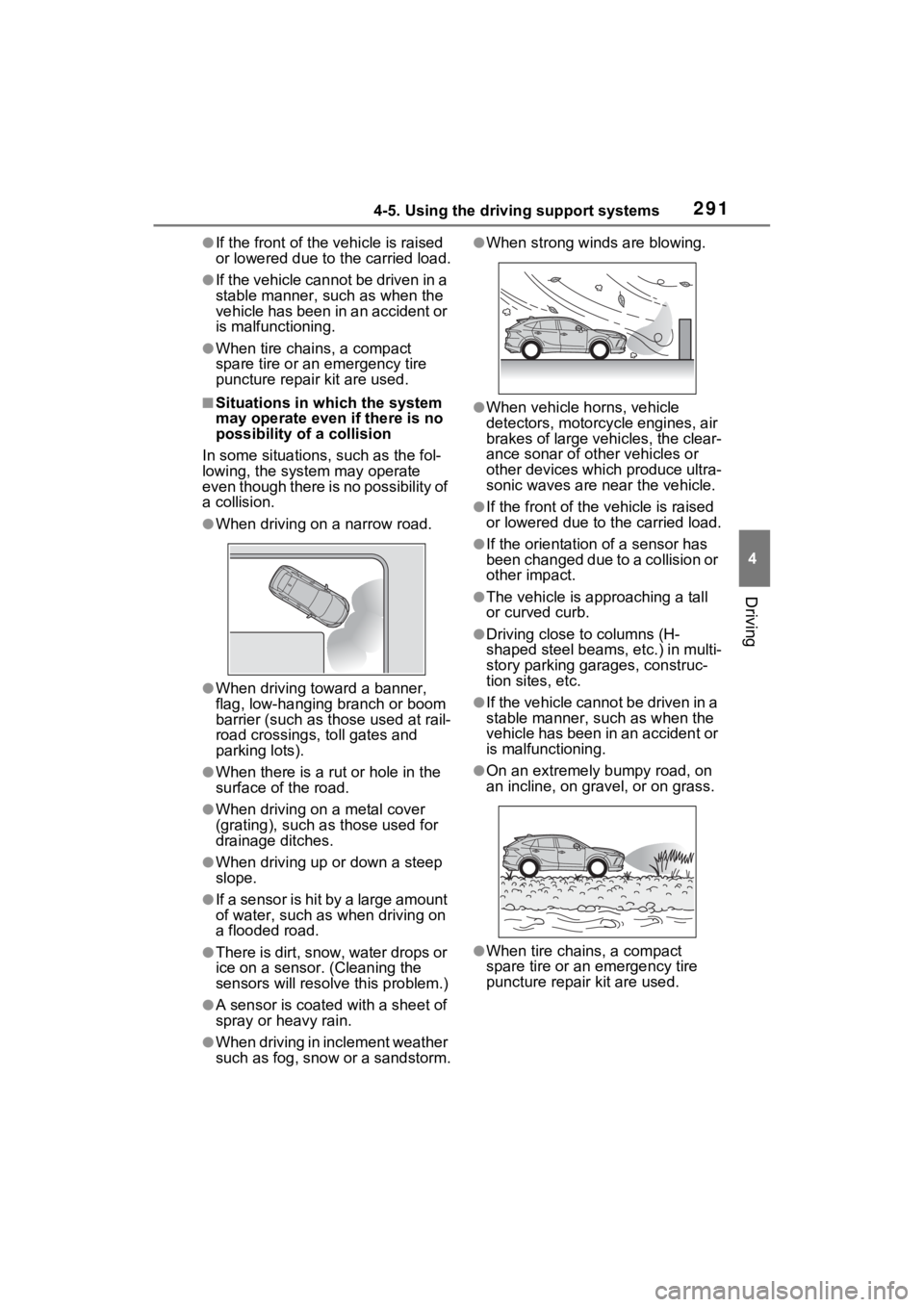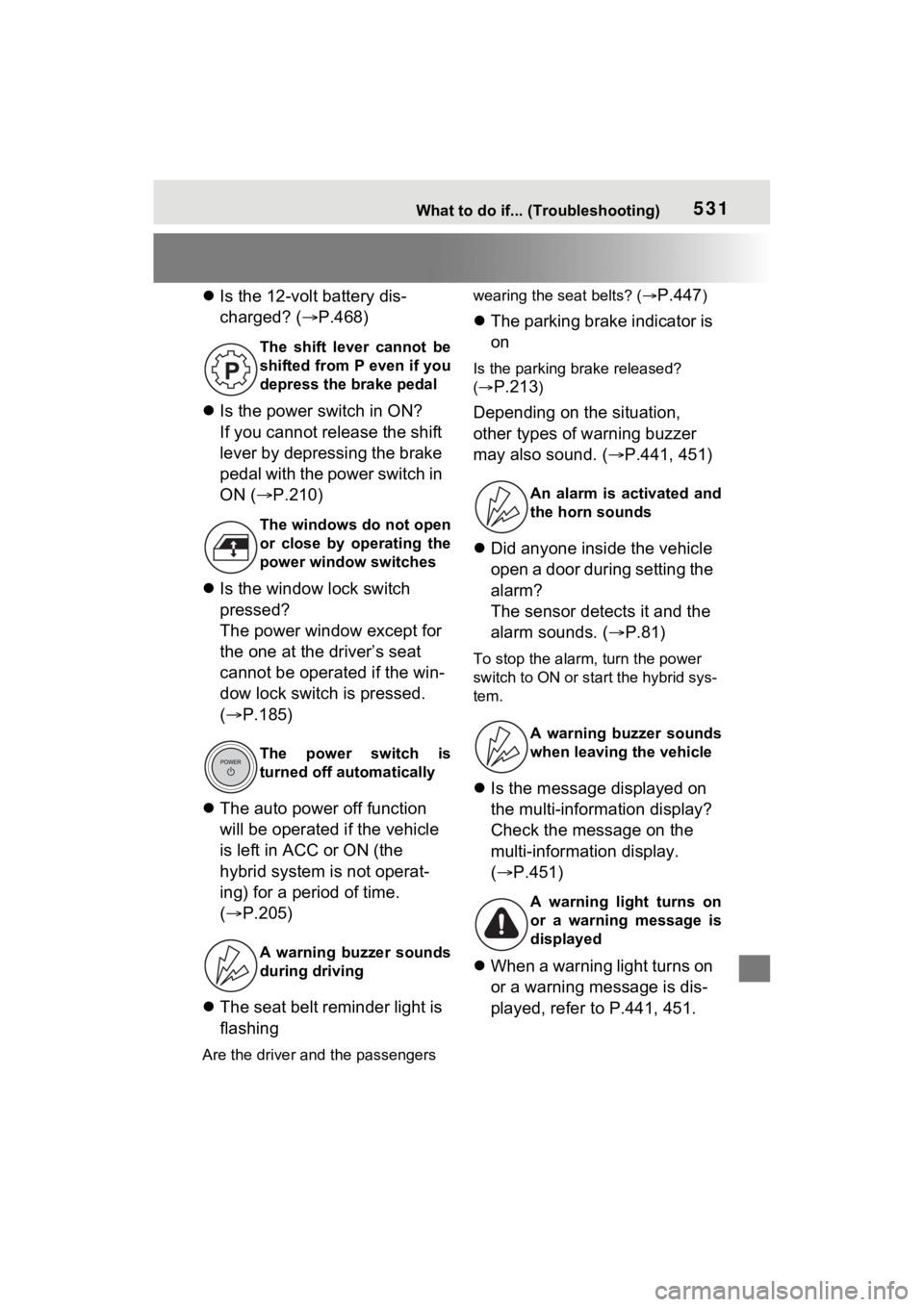2023 TOYOTA VENZA HYBRID horn
[x] Cancel search: hornPage 168 of 560

1683-4. Adjusting the steering wheel and mirrors
3-4.Adjusting the steering wheel and mirrors
Operating the switch moves the
steering wheel in the following
directions:
1Up
2 Down
3 Toward the driver
4 Away from the driver
■The steering wheel can be
adjusted when
The power switch is in ACC or ON
*.
*: If the driver’s seat belt is fastened,
the steering wheel can be
adjusted regardless of power
switch mode.
■Auto tilt away (if equipped)
The steering wheel move in accor-
dance with power switch mode and
the driver’s seat belt condition.
■Automatic adjustment of the
steering position (if equipped)
A desired steering position can be
entered to memory and recalled
automatically by the driving position
memory system. ( P.163)
To sound the horn, press on or
close to the mark.
Steering wheel
Adjustment procedure
WARNING
■Caution while driving
Do not adjust the steering wheel
while driving.
Doing so may cause the driver to
mishandle the vehicle and cause
an accident, resulting in death or
serious injury.
Sounding the horn
Page 290 of 560

2904-5. Using the driving support systems
audio system or air flow noise of
the air conditioning system.
●It may be difficult to hear the
sound of this system due to the
buzzers of other systems.
■Objects which the system may
not properly detect
The shape of the object may pre-
vent the sensor from detecting it.
Pay particular attention to the fol-
lowing objects:
●Wires, fences, ropes, etc.
●Cotton, snow and other materials
that absorb sound waves
●Sharply-angled objects
●Low objects
●Tall objects with upper sections
projecting outwards in the direc-
tion of your vehicle
People may not be detected if they
are wearing certain types of cloth-
ing.
■Situations in which the system
may not operate properly
Certain vehicle conditions and the
surrounding environment may affect
the ability of a sensor to correctly
detect objects. Particular instances
where this may occur are listed
below.
●There is dirt, snow or ice on a sen-
sor. (Cleaning the sensors will
resolve this problem.)
●A sensor is frozen. (Thawing the
area will resolve this problem.)
In especially cold weather, if a
sensor is frozen the sensor dis-
play may be displayed abnor-
mally, or objects, such as a wall,
may not be detected.
●When a sensor or the area around
a sensor is extremely hot or cold.
●On an extremely bumpy road, on
an incline, on gravel, or on grass.
●When vehicle horns, vehicle
detectors, motorcycle engines, air
brakes of large vehicles, the clear-
ance sonar of ot her vehicles or
other devices which produce ultra-
sonic waves are near the vehicle.
●A sensor is coated with a sheet of
spray or heavy rain.
●If objects draw too close to the
sensor.
●When a pedestrian is wearing
clothing that does not reflect ultra-
sonic waves (ex. skirts with gath-
ers or frills).
●When objects that are not perpen-
dicular to the ground, not perpen-
dicular to the vehicle traveling
direction, uneven, or waving are in
the detection range.
●Strong wind is blowing.
●When driving in inclement weather
such as fog, snow or a sandstorm.
●When an object that cannot be
detected is between the vehicle
and a detected object.
●If an object such as a vehicle,
motorcycle, bicycle or pedestrian
cuts in front of the vehicle or runs
out from the side of the vehicle.
●If the orientation of a sensor has
been changed due to a collision or
other impact.
●When equipment that may
obstruct a sensor is installed, such
as a towing eyelet, bumper pro-
tector (an additional trim strip,
etc.), bicycle c arrier, or snow
plow.
Page 291 of 560

2914-5. Using the driving support systems
4
Driving
●If the front of the vehicle is raised
or lowered due to the carried load.
●If the vehicle cannot be driven in a
stable manner, such as when the
vehicle has been in an accident or
is malfunctioning.
●When tire chains, a compact
spare tire or an emergency tire
puncture repair kit are used.
■Situations in which the system
may operate even if there is no
possibility of a collision
In some situations, such as the fol-
lowing, the system may operate
even though there is no possibility of
a collision.
●When driving on a narrow road.
●When driving toward a banner,
flag, low-hanging branch or boom
barrier (such as those used at rail-
road crossings, toll gates and
parking lots).
●When there is a rut or hole in the
surface of the road.
●When driving on a metal cover
(grating), such as those used for
drainage ditches.
●When driving up or down a steep
slope.
●If a sensor is hit by a large amount
of water, such as when driving on
a flooded road.
●There is dirt, snow, water drops or
ice on a sensor. (Cleaning the
sensors will resolve this problem.)
●A sensor is coated with a sheet of
spray or heavy rain.
●When driving in inclement weather
such as fog, snow or a sandstorm.
●When strong winds are blowing.
●When vehicle horns, vehicle
detectors, motorcycle engines, air
brakes of large vehicles, the clear-
ance sonar of ot her vehicles or
other devices which produce ultra-
sonic waves are near the vehicle.
●If the front of the v ehicle is raised
or lowered due to the carried load.
●If the orientation of a sensor has
been changed due to a collision or
other impact.
●The vehicle is approaching a tall
or curved curb.
●Driving close to columns (H-
shaped steel beams, etc.) in multi-
story parking garages, construc-
tion sites, etc.
●If the vehicle cannot be driven in a
stable manner, such as when the
vehicle has been in an accident or
is malfunctioning.
●On an extremely bumpy road, on
an incline, on gravel, or on grass.
●When tire chains, a compact
spare tire or an emergency tire
puncture repai r kit are used.
Page 464 of 560
![TOYOTA VENZA HYBRID 2023 Owners Manual 4647-2. Steps to take in an emergency
extremely low (approximately
below -22°F [-30°C]). ( P.76,
202)
One of the following may be the
cause of the problem:
The 12-volt battery may be
disc TOYOTA VENZA HYBRID 2023 Owners Manual 4647-2. Steps to take in an emergency
extremely low (approximately
below -22°F [-30°C]). ( P.76,
202)
One of the following may be the
cause of the problem:
The 12-volt battery may be
disc](/manual-img/14/59274/w960_59274-463.png)
4647-2. Steps to take in an emergency
extremely low (approximately
below -22°F [-30°C]). ( P.76,
202)
One of the following may be the
cause of the problem:
The 12-volt battery may be
discharged. ( P.468)
The 12-volt battery terminal
connections may be loose or
corroded. ( P.399)
One of the following may be the
cause of the problem:
The 12-volt battery may be
discharged. ( P.468)
One or both of the 12-volt bat-
tery terminals may be discon-
nected. ( P.399)
Contact your Toyota dealer if
the problem cannot be repaired,
or if repair procedures are
unknown.
When the hybrid system does not start, the following steps can
be used as an interim measure
to start the hybrid system if the
power switch is functioning nor-
mally.
Do not use this starting proce-
dure except in cases of emer-
gency.
1
Pull the parking brake switch
to check that the parking
brake is set. ( P.213)
Parking brake indicator will come
on.
2 Shift the shift lever to P.
3 Turn the power switch to
ACC.
4 Press and hold the power
switch for about 15 seconds
while depressing the brake
pedal firmly.
Even if the hybrid system can be
started using the above steps,
the system may be malfunction-
ing. Have the vehicle inspected
by your Toyota dealer.
The interior lights and
headlights are dim, or the
horn does not sound or
sounds at a low volume
The interior lights and
headlights do not turn on,
or the horn does not
sound
Starting the hybrid sys-
tem in an emergency
Page 531 of 560

531What to do if... (Troubleshooting)
Is the 12-volt battery dis-
charged? ( P.468)
Is the power switch in ON?
If you cannot release the shift
lever by depressing the brake
pedal with the power switch in
ON ( P.210)
Is the window lock switch
pressed?
The power window except for
the one at the driver’s seat
cannot be operated if the win-
dow lock switch is pressed.
( P.185)
The auto power off function
will be operated if the vehicle
is left in ACC or ON (the
hybrid system is not operat-
ing) for a period of time.
( P.205)
The seat belt reminder light is
flashing
Are the driver and the passengers wearing the seat belts? (
P.447)
The parking brake indicator is
on
Is the parking br ake released?
(
P.213)
Depending on the situation,
other types of warning buzzer
may also sound. ( P.441, 451)
Did anyone inside the vehicle
open a door during setting the
alarm?
The sensor detects it and the
alarm sounds. ( P.81)
To stop the alarm, turn the power
switch to ON or start the hybrid sys-
tem.
Is the message displayed on
the multi-information display?
Check the message on the
multi-information display.
( P.451)
When a warning light turns on
or a warning message is dis-
played, refer to P.441, 451.
The shift lever cannot be
shifted from P even if you
depress the brake pedal
The windows do not open
or close by operating the
power window switches
The power switch is
turned off automatically
A warning buzzer sounds
during driving
An alarm is activated and
the horn sounds
A warning buzzer sounds
when leaving the vehicle
A warning light turns on
or a warning message is
displayed
Page 538 of 560

538Alphabetical Index
Settings ................................ 124
Heated steering wheel ........... 337
Heaters Automatic air conditioning sys-tem ............................. 320, 328
Heated steering wheel ......... 337
Outside rear view mirrors ... 322, 330
Seat heaters ......................... 337
High mounted stoplight Replacing light bulbs ............ 430
Hill-start assist control .......... 306
Hood ........................................ 387
Hooks Coat hooks ........................... 363
Retaining hooks (floor mat) .... 26
Horn ......................................... 168
Hybrid battery (tr action battery)
Location.................................. 75
Specification ......................... 482
Hybrid battery air vent ............. 78
Hybrid system .......................... 70 ACC...................................... 204
Emergency shut off system .... 78
Energy monitor/consumption screen ................................ 128
EV drive mode...................... 206
High voltage components....... 75
How to start the hybrid system ........................................... 201
Hybrid Electric vehicle driving tips...................................... 311
Hybrid System In dicator . 90, 123
Hybrid system precautions ..... 75
If the hybrid sy stem will not start
........................................... 463
If your vehicle has to be stopped in an emergency................. 433
Ignition switch (power switch) ........................................... 201
Overheating.......................... 473
Power (ignition) switch ......... 201 Regenerative braking .............71
Starting the hybrid system ....201
Hybrid System Indicator ..90, 123
Hybrid transmissio n ...............208
S mode .................................210
I
I/M test .....................................383
Identification Engine ..................................481
Vehicle..................................480
Ignition switch (power switch) ...............................................201Auto power off fun ction.........205
Changing the power switch modes.................................204
If your vehicle has to be stopped in an emergency .................433
Starting the hybrid system ....201
Immobilizer system ..................80
Indicators ..................................84
Initialization Items to initialize ...................515
Maintenance .........................380
Power back door ..................149
Power windows ....................183
Tire pressure warning system...........................................406
Inside rear view m irror ...169, 170
Instrument panel light control .93
Interior lights...........................339 Switch ...................................340
Intuitive parking assist Function................................287
Warning message . ...............289
J
Jack
Positioning a floor jack .........388
Vehicle-equipped jack ..........457
Jack handle .............................457